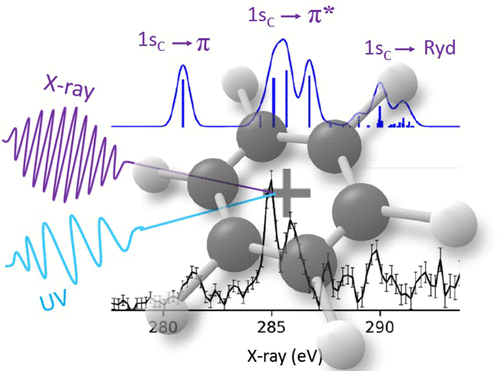当前位置:
X-MOL 学术
›
J. Phys. Chem. A
›
论文详情
Our official English website, www.x-mol.net, welcomes your
feedback! (Note: you will need to create a separate account there.)
Interplay of Open-Shell Spin-Coupling and Jahn–Teller Distortion in Benzene Radical Cation Probed by X-ray Spectroscopy
The Journal of Physical Chemistry A ( IF 2.7 ) Pub Date : 2020-10-26 , DOI: 10.1021/acs.jpca.0c08732 Marta L. Vidal 1 , Michael Epshtein 2, 3 , Valeriu Scutelnic 2 , Zheyue Yang 2 , Tian Xue 2 , Stephen R. Leone 2, 4 , Anna I. Krylov 5 , Sonia Coriani 1
The Journal of Physical Chemistry A ( IF 2.7 ) Pub Date : 2020-10-26 , DOI: 10.1021/acs.jpca.0c08732 Marta L. Vidal 1 , Michael Epshtein 2, 3 , Valeriu Scutelnic 2 , Zheyue Yang 2 , Tian Xue 2 , Stephen R. Leone 2, 4 , Anna I. Krylov 5 , Sonia Coriani 1
Affiliation

|
We report a theoretical investigation and elucidation of the X-ray absorption spectra of neutral benzene and of the benzene cation. The generation of the cation by multiphoton ultraviolet (UV) ionization and the measurement of the carbon K-edge spectra of both species using a table-top high-harmonic generation source are described in the companion experimental paper [Epshtein, M.; et al. J. Phys. Chem. Ahttp://dx.doi.org/10.1021/acs.jpca.0c08736]. We show that the 1sC → π transition serves as a sensitive signature of the transient cation formation, as it occurs outside of the spectral window of the parent neutral species. Moreover, the presence of the unpaired (spectator) electron in the π-subshell of the cation and the high symmetry of the system result in significant differences relative to neutral benzene in the spectral features associated with the 1sC → π* transitions. High-level calculations using equation-of-motion coupled-cluster theory provide the interpretation of the experimental spectra and insight into the electronic structure of benzene and its cation. The prominent split structure of the 1sC → π* band of the cation is attributed to the interplay between the coupling of the core → π* excitation with the unpaired electron in the π-subshell and the Jahn–Teller distortion. The calculations attribute most of the splitting (∼1–1.2 eV) to the spin coupling, which is visible already at the Franck–Condon structure, and we estimate the additional splitting due to structural relaxation to be around ∼0.1–0.2 eV. These results suggest that X-ray absorption with increased resolution might be able to disentangle electronic and structural aspects of the Jahn–Teller effect in the benzene cation.
中文翻译:

X射线光谱探测苯自由基中开壳自旋耦合和Jahn-Teller畸变的相互作用
我们报告了中性苯和苯阳离子的X射线吸收光谱的理论研究和阐明。伴随的实验论文[Epshtein,M。]中描述了通过多光子紫外线(UV)电离产生阳离子以及使用台式高谐波产生源测量两种物种的碳K边缘光谱。等。J.物理 化学 一个http://dx.doi.org/10.1021/acs.jpca.0c08736。我们证明1s C→π跃迁是瞬态阳离子形成的敏感特征,因为它发生在母体中性物种的光谱窗口之外。此外,阳离子的π-子壳中不成对的(旁观者)电子的存在和系统的高度对称性导致与1s C →π*跃迁相关的光谱特征相对于中性苯有显着差异。使用运动方程耦合簇理论进行的高级计算提供了实验光谱的解释,并深入了解了苯及其阳离子的电子结构。1s C的突出拆分结构阳离子的π*带归因于核的耦合→π*激发与π-子壳中未成对电子的相互作用与Jahn-Teller畸变之间的相互作用。计算结果将大部分分裂(约1–1.2 eV)归因于自旋耦合,这在Franck–Condon结构上已经可见,并且我们估计由于结构弛豫而引起的额外分裂约为0.1〜0.2 eV。这些结果表明,具有更高分辨率的X射线吸收可能能够解开苯阳离子中Jahn–Teller效应的电子和结构方面。
更新日期:2020-11-19
中文翻译:

X射线光谱探测苯自由基中开壳自旋耦合和Jahn-Teller畸变的相互作用
我们报告了中性苯和苯阳离子的X射线吸收光谱的理论研究和阐明。伴随的实验论文[Epshtein,M。]中描述了通过多光子紫外线(UV)电离产生阳离子以及使用台式高谐波产生源测量两种物种的碳K边缘光谱。等。J.物理 化学 一个http://dx.doi.org/10.1021/acs.jpca.0c08736。我们证明1s C→π跃迁是瞬态阳离子形成的敏感特征,因为它发生在母体中性物种的光谱窗口之外。此外,阳离子的π-子壳中不成对的(旁观者)电子的存在和系统的高度对称性导致与1s C →π*跃迁相关的光谱特征相对于中性苯有显着差异。使用运动方程耦合簇理论进行的高级计算提供了实验光谱的解释,并深入了解了苯及其阳离子的电子结构。1s C的突出拆分结构阳离子的π*带归因于核的耦合→π*激发与π-子壳中未成对电子的相互作用与Jahn-Teller畸变之间的相互作用。计算结果将大部分分裂(约1–1.2 eV)归因于自旋耦合,这在Franck–Condon结构上已经可见,并且我们估计由于结构弛豫而引起的额外分裂约为0.1〜0.2 eV。这些结果表明,具有更高分辨率的X射线吸收可能能够解开苯阳离子中Jahn–Teller效应的电子和结构方面。











































 京公网安备 11010802027423号
京公网安备 11010802027423号